Related Research Articles

Gundagai is a town in New South Wales, Australia. Although a small town, Gundagai is a popular topic for writers and has become a representative icon of a typical Australian country town. Located along the Murrumbidgee River and Muniong, Honeysuckle, Kimo, Mooney Mooney, Murrumbidgee and Tumut mountain ranges, Gundagai is 390 kilometres (240 mi) south-west of Sydney. Until 2016, Gundagai was the administrative centre of Gundagai Shire local government area. In the 2021 census, the population of Gundagai was 2,057.
Lasseter's Reef refers to the purported discovery, announced by Harold Bell Lasseter in 1929 and 1930, of a fabulously rich gold deposit in a remote and desolate corner of central Australia. Lasseter's accounts of the find are conflicting and its precise location remains a mystery—if it exists.
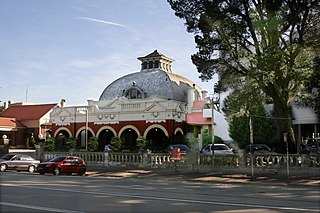
The Hydro Majestic Hotel is located in Medlow Bath, New South Wales, Australia. The hotel is located on a clifftop overlooking the Megalong Valley on the western side of the Great Western Highway.

Lewis Harold Bell Lasseter, also known as Harold Lasseter, was an Australian gold prospector who claimed to have found a fabulously rich gold reef in central Australia.

Ion Llewellyn Idriess was a prolific and influential Australian author. He wrote more than 50 books over 43 years between 1927 and 1969 – an average of one book every 10 months, and twice published three books in one year. His first book was Madman's Island, published in 1927 at the age of 38, and his last was written at the age of 79. Called Challenge of the North, it told of Idriess's ideas for developing the north of Australia.
Rupert Kathner (1904–1954) was an Australian film director best known for newsreels and low-budget films. He worked with Alma Brooks, an ex-barmaid, who co-produced, operated the camera, edited, co-scripted and acted in their films. Kathner and Brooks were also "shady con artists and fugitives from the law", sometimes described as the "Bonnie and Clyde" of the Australian film industry.
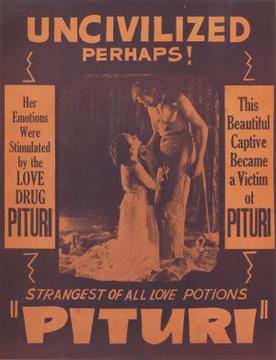
Uncivilised is a 1936 Australian film directed by Charles Chauvel. It was an attempt by Chauvel to make a more obviously commercial film, and was clearly influenced by Tarzan.
The 1968 Australian Film Awards ceremony, presented by the Australian Film Institute (AFI), honoured the best feature and non-feature films of 1969, and took place on 2 December 1969 at National Library Theatre, in Canberra, Australian Capital Territory. Australian Prime Minister John Gorton hosted the ceremony. During the ceremony the Australian Film Institute presented two gold, nine silver and bronze prizes, four special awards and certificates for twelve honourable mentions.
White Death is a 1936 Australian film directed by Edwin G. Bowen and starring Zane Grey as himself. He filmed it during a fishing expedition to Australia and it marked the first time he had played a leading role in a film.
Below the Surface is a 1938 adventure film set in the coal region of Newcastle, Australia. Only part of the movie survives.
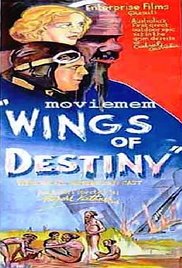
Wings of Destiny is a 1940 action war film directed by Rupert Kathner and starring Marshall Crosby and John Fernside. The film is about the activities of fifth columnists in Australia during the Second World War. Wings of Destiny was one of the first films of the war to depict fifth columnists as well as the aboriginal Australians.
The Glenrowan Affair is a 1951 movie about Ned Kelly from director Rupert Kathner. It was Kathner's final film and stars VFL star Bob Chitty as Kelly. It is considered one of the worst films ever made in Australia.
The Burgomeister is a 1935 Australian film directed by Harry Southwell based on the 1867 play Le juif polonais by Erckmann-Chatrian, adapted into English in 1871 by Leopold Lewis, previously filmed a number of times. The Burgomeister (1935) is considered a 'substantially lost' film, with only one sequence surviving.
Typhoon Treasure is a 1938 Australian adventure film directed by Noel Monkman and starring Campbell Copelin, Gwen Munro, and Joe Valli. It is set in New Guinea although shot on the Great Barrier Reef and the Queensland coast. It was Monkman's first dramatic feature film after several years making documentaries.
Stan Tolhurst was an Australian actor, technician and filmmaker. He worked as a dancer on stage before joining Cinesound Productions for whom he would add humour to newsreels. He also worked as a producer and ran a film studio.

Lasseter's Last Ride is an Australian book by Ion Idriess.
Walter Smith also known as Walter Purula (Perrurle) or Wati Yuritja was a legendary Australian bushman from the Arltunga region in the Northern Territory of Australia. Wati Yuritja translates as man of the Water Dreaming).
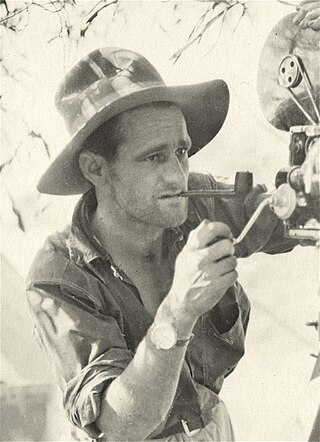
Ernest Gustav Brandon-Cremer was a New Zealand/Australian moviemaker, newsman, explorer and adventurer. He was a key figure in Australian aviation history, and was especially known for his documentation of Lasseter's Gold Reef as well as his photography of the Solar eclipse of 21 September 1922 at Wallal, Australia.
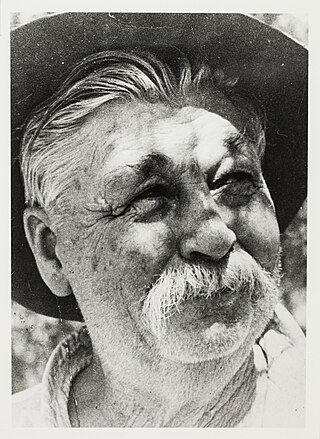
Robert Henry Buck was an Australian pastoralist and bushman who is best remembered as being one of the people to recover the body of Lewis Harold Bell Lasseter.
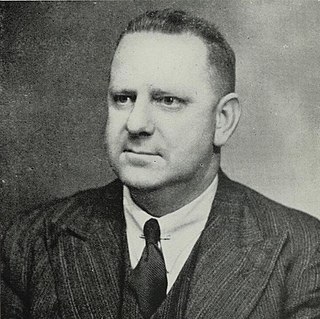
Lindsay Gordon Scott ARAIA was a prominent Sydney architect best associated for his design of the Erskineville Town Hall and numerous surf pavilions in New South Wales, including several on the Northern Beaches of Sydney.
References
- ↑ "Advertising". Singleton Argus . NSW: National Library of Australia. 18 June 1937. p. 7. Retrieved 13 August 2012.
- ↑ ""PHANTOM GOLD"". Singleton Argus . NSW: National Library of Australia. 21 June 1937. p. 4. Retrieved 13 August 2012.
- ↑ "AMUSEMENTS". The Sydney Morning Herald . National Library of Australia. 24 September 1937. p. 3. Retrieved 13 August 2012.
- ↑ "MINING EXPEDITION". The Sydney Morning Herald . National Library of Australia. 20 April 1936. p. 6. Retrieved 13 August 2012.
- 1 2 3 Andrew Pike and Ross Cooper, Australian Film 1900–1977: A Guide to Feature Film Production, Melbourne: Oxford University Press, 1998, p178
- ↑ "PAINTED UP FOR BUSH FILM". The Advertiser . Adelaide: National Library of Australia. 4 July 1936. p. 33. Retrieved 13 August 2012.
- ↑ "ABORIGINES ATTACK GOLD SEARCHERS". The Advertiser . Adelaide: National Library of Australia. 18 June 1936. p. 15. Retrieved 13 August 2012.
- ↑ "HUMMERSTON'S "WILD NATIVES"". The Barrier Miner . Broken Hill, NSW: National Library of Australia. 3 July 1936. p. 3. Retrieved 13 August 2012.
- ↑ ""PHANTOM GOLD."". The Sydney Morning Herald . National Library of Australia. 27 September 1937. p. 6. Retrieved 13 August 2012.
- ↑ Michael Adams, Showgirls, Teen Wolves, and Astro Zombies : a film critic's year-long quest to find the worst movie ever made.New York : Itbooks, 2010. ISBN 978-0-06-180629-2 (p.144)